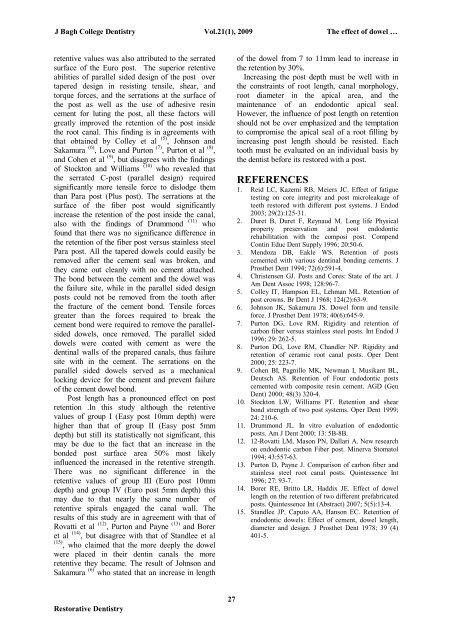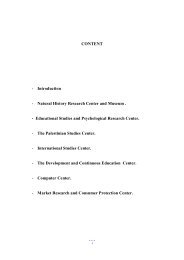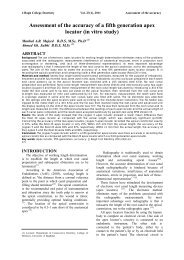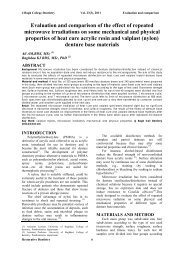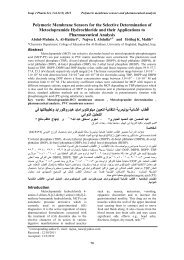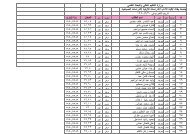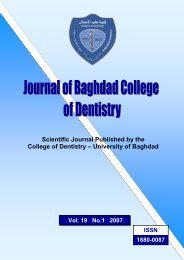Vol 21 No. 1
Vol 21 No. 1
Vol 21 No. 1
Create successful ePaper yourself
Turn your PDF publications into a flip-book with our unique Google optimized e-Paper software.
J Bagh College Dentistry <strong>Vol</strong>.<strong>21</strong>(1), 2009 The effect of dowel …<br />
retentive values was also attributed to the serrated<br />
surface of the Euro post. The superior retentive<br />
abilities of parallel sided design of the post over<br />
tapered design in resisting tensile, shear, and<br />
torque forces, and the serrations at the surface of<br />
the post as well as the use of adhesive resin<br />
cement for luting the post, all these factors will<br />
greatly improved the retention of the post inside<br />
the root canal. This finding is in agreements with<br />
that obtained by Colley et al (5) , Johnson and<br />
Sakamura (6) , Love and Purton (7) , Purton et al (8) ,<br />
and Cohen et al (9) , but disagrees with the findings<br />
of Stockton and Williams (10) who revealed that<br />
the serrated C-post (parallel design) required<br />
significantly more tensile force to dislodge them<br />
than Para post (Plus post). The serrations at the<br />
surface of the fiber post would significantly<br />
increase the retention of the post inside the canal,<br />
also with the findings of Drummond (11) who<br />
found that there was no significance difference in<br />
the retention of the fiber post versus stainless steel<br />
Para post. All the tapered dowels could easily be<br />
removed after the cement seal was broken, and<br />
they came out cleanly with no cement attached.<br />
The bond between the cement and the dowel was<br />
the failure site, while in the parallel sided design<br />
posts could not be removed from the tooth after<br />
the fracture of the cement bond. Tensile forces<br />
greater than the forces required to break the<br />
cement bond were required to remove the parallelsided<br />
dowels, once removed. The parallel sided<br />
dowels were coated with cement as were the<br />
dentinal walls of the prepared canals, thus failure<br />
site with in the cement. The serrations on the<br />
parallel sided dowels served as a mechanical<br />
locking device for the cement and prevent failure<br />
of the cement dowel bond.<br />
Post length has a pronounced effect on post<br />
retention .In this study although the retentive<br />
values of group Ι (Easy post 10mm depth) were<br />
higher than that of group ΙΙ (Easy post 5mm<br />
depth) but still its statistically not significant, this<br />
may be due to the fact that an increase in the<br />
bonded post surface area 50% most likely<br />
influenced the increased in the retentive strength.<br />
There was no significant difference in the<br />
retentive values of group ΙΙΙ (Euro post 10mm<br />
depth) and group ΙV (Euro post 5mm depth) this<br />
may due to that nearly the same number of<br />
retentive spirals engaged the canal wall. The<br />
results of this study are in agreement with that of<br />
Rovatti et al (12) , Purton and Payne (13) and Borer<br />
et al (14) , but disagree with that of Standlee et al<br />
(15) , who claimed that the more deeply the dowel<br />
were placed in their dentin canals the more<br />
retentive they became. The result of Johnson and<br />
Sakamura (6) who stated that an increase in length<br />
of the dowel from 7 to 11mm lead to increase in<br />
the retention by 30%.<br />
Increasing the post depth must be well with in<br />
the constraints of root length, canal morphology,<br />
root diameter in the apical area, and the<br />
maintenance of an endodontic apical seal.<br />
However, the influence of post length on retention<br />
should not be over emphasized and the temptation<br />
to compromise the apical seal of a root filling by<br />
increasing post length should be resisted. Each<br />
tooth must be evaluated on an individual basis by<br />
the dentist before its restored with a post.<br />
REFERENCES<br />
1. Reid LC, Kazemi RB, Meiers JC. Effect of fatigue<br />
testing on core integrity and post microleakage of<br />
teeth restored with different post systems. J Endod<br />
2003; 29(2):125-31.<br />
2. Duret B, Duret F, Reynaud M. Long life Physical<br />
property preservation and post endodontic<br />
rehabilitation with the composi post. Compend<br />
Contin Educ Dent Supply 1996; 20:50-6.<br />
3. Mendoza DB, Eakle WS. Retention of posts<br />
cemented with various dentinal bonding cements. J<br />
Prosthet Dent 1994; 72(6):591-4.<br />
4. Christensen GJ. Posts and Cores: State of the art. J<br />
Am Dent Assoc 1998; 128:96-7.<br />
5. Colley IT, Hampson EL, Lehman ML. Retention of<br />
post crowns. Br Dent J 1968; 124(2):63-9.<br />
6. Johnson JK, Sakamura JS. Dowel form and tensile<br />
force. J Prosthet Dent 1978; 40(6):645-9.<br />
7. Purton DG, Love RM. Rigidity and retention of<br />
carbon fiber versus stainless steel posts. Int Endod J<br />
1996; 29: 262-5.<br />
8. Purton DG, Love RM, Chandler NP. Rigidity and<br />
retention of ceramic root canal posts. Oper Dent<br />
2000; 25: 223-7.<br />
9. Cohen BI, Pagnillo MK, Newman I, Musikant BL,<br />
Deutsch AS. Retention of Four endodontic posts<br />
cemented with composite resin cement. AGD (Gen<br />
Dent) 2000; 48(3) 320-4.<br />
10. Stockton LW, Williams PT. Retention and shear<br />
bond strength of two post systems. Oper Dent 1999;<br />
24: <strong>21</strong>0-6.<br />
11. Drummond JL. In vitro evaluation of endodontic<br />
posts. Am J Dent 2000; 13: 5B-8B.<br />
12. 12-Rovatti LM, Mason PN, Dallari A. New research<br />
on endodontic carbon Fiber post. Minerva Stomatol<br />
1994; 43:557-63.<br />
13. Purton D, Payne J. Comparison of carbon fiber and<br />
stainless steel root canal posts. Quintessence Int<br />
1996; 27: 93-7.<br />
14. Borer RE, Britto LR, Haddix JE. Effect of dowel<br />
length on the retention of two different prefabricated<br />
posts. Quintessence Int (Abstract) 2007; 5(5):13-4.<br />
15. Standlee JP, Caputo AA, Hanson EC. Retention of<br />
endodontic dowels: Effect of cement, dowel length,<br />
diameter and design. J Prosthet Dent 1978; 39 (4)<br />
401-5.<br />
Restorative Dentistry<br />
27


